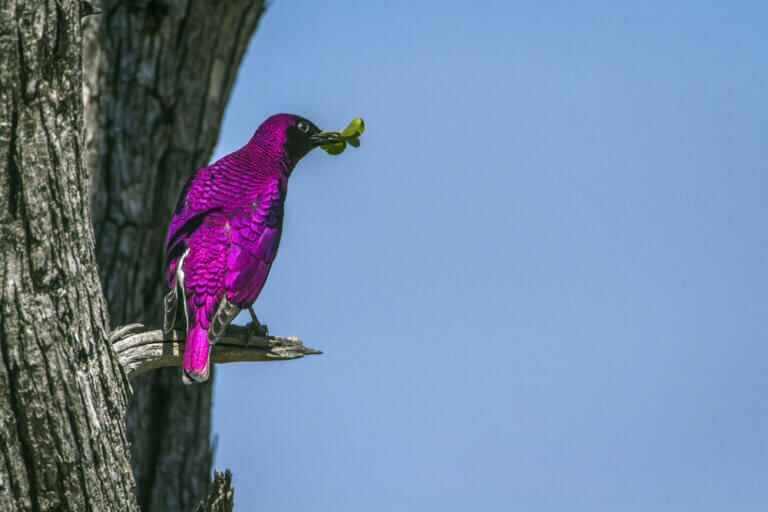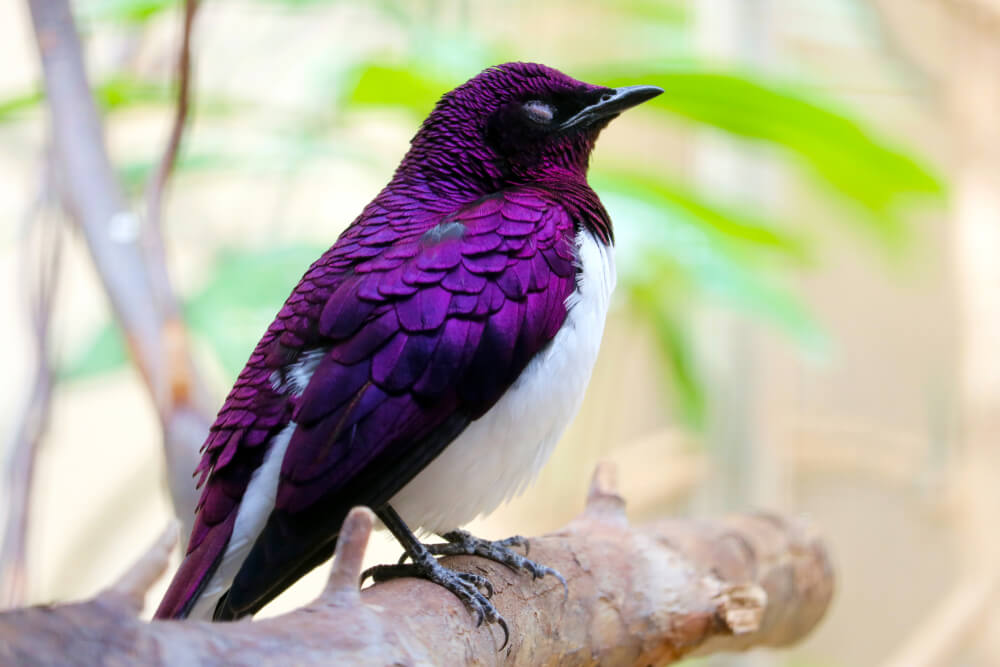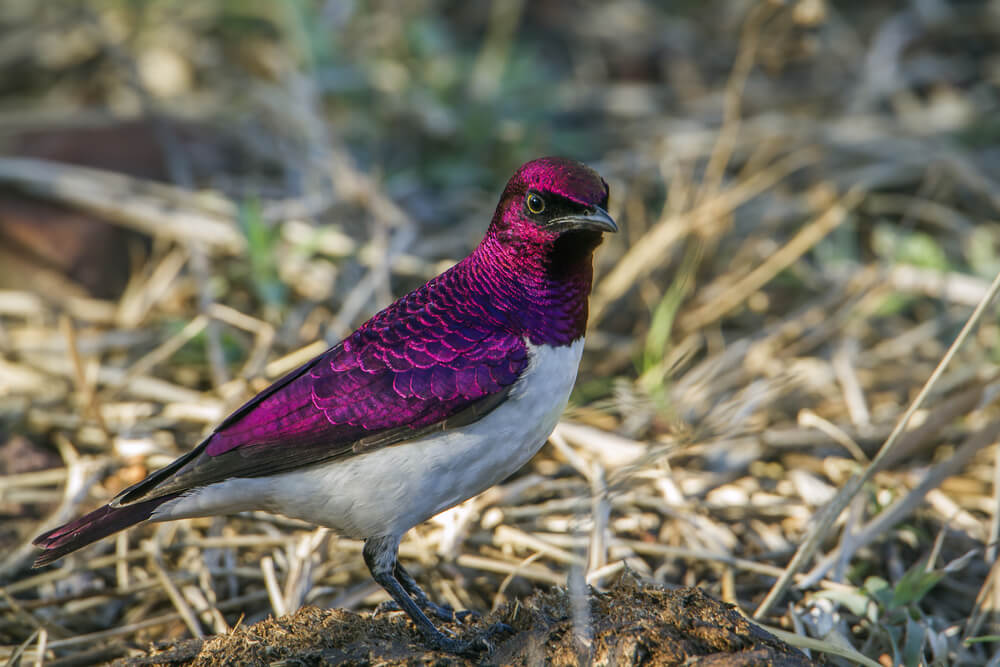The Violet-Backed Starling and the Secret Behind its Metallic Plumage


Written and verified by biochemistry Luz Eduviges Thomas-Romero
The violet-backed starling (Cinnyricinclus leucogaster), also known as the plum-colored starling, is the only member of the genus Cinnyricinclus that belongs to the starling family (order Passeriformes). This fascinating animal inhabits the savanna forests of sub-Saharan Africa.
Although many starlings have dull plumage, the violet-backed starling’s is metallic. This species, which stands out due to its wonderful color, includes species of various genera:
- Superb starling (Lamprotornis superbus) from East Africa
- The golden-breasted starling (Lamprotornis regius), also from East Africa
- Metallic starling or shining starling (Aplonis metallica) from the Pacific Islands
Strong sexual dimorphism
This bird is relatively small (six inches, and weighing one ounce). Only the male violet-backed starling has a white breast and the striking iridescent violet back that characterizes the species. Females and young birds have a brown head and back, with a white belly with brown spots. Both males and females have black beaks and legs.

Distribution and habitat of the violet-backed starling
This bird species is widely distributed, as it’s found from the southwest of the Arabian Peninsula to sub-Saharan Africa. It’s commonly found in tropical forests and savannas. However, you can also see find it in parks and gardens in human settlements. However, you’ll rarely see it on the ground. Instead, it’s found in trees and high places.
In general, the violet-backed starling is found throughout the African forested savanna, both north and south of the equatorial forests. According to scientific reports, the species is partially migratory. Thus, it strays away from the equator to reproduce just before and during periods of rain and returns during the following dry season.
Until now, experts recognize three subspecies, with their own geographical distribution:
- Cinnyricinclus leucogaster leucogaster. Found in Senegal and Gambia, to Ethiopia, Kenya, and Tanzania.
- Cinnyricinclus leucogaster arabicus. Found in east Sudan, to northwest Somalia, and the Arabian Peninsula.
- Cinnyricinclus leucogaster verreauxi is widespread in the south of the Democratic Republic of the Congo to west Tanzania, south to Botswana, and then northeast South Africa, and Mozambique.
Life habits of the violet-backed starling
These birds are very sociable, as they live together in colonies. In addition, they mostly eat fruit, but also eat insects, especially termites that they catch in flight. As for nests, this bird makes them in caves in old trees, using feathers, plant material, and feces. The female can lay up to six eggs, which incubate for approximately 14 to 18 days.
Why is plumage coloration important?
In nature, coloring patterns are a key element for sexual selection. Often, the coloration of species plays a role in inter and intraspecific communication.
It’s interesting to know that the different patterns found in nature have hardly been investigated, perhaps due to how hard it is to effectively capture their variability with the usual methods.
The plumage of the violet-backed starling
First of all, it’s important to note that there are two types of plumage colorations, as happens in butterflies and other animals:
- Pigment-based color. It includes melanins, carotenoids, and others. They make up a small color palette.
- Structural color. Formed by the effect of light on nanostructures. Iridescent colors are often the result of the feather’s structure. Due to this mechanism, a wide range of iridescent colors is possible.
How a feather gets its color
Tiny follicles in the epidermis, or outer skin layer, produce keratin proteins that form the feathers. The barbs correspond to each “hair”, which branch perpendicularly into barbules. In turn, these barbules branch into barbicels. The barbicels of the adjoining barbules hook together in the feather, giving it its structure.
In plumage, structural coloration is the product of nanoscale arrangements of various elements. In other words, keratin plaques, melanosomes, and also the air inside the feather barbules. Of course, the same bird species can have feathers with colors produced by different mechanisms and pigments. Furthermore, it’s common for the same plumage to present combinations of both mechanisms.
Melanosomes, small bundles of melanin found in the feathers, skin, and fur of many animals, can produce structural colors when they’re properly organized into solid layers.
Why are the colors of the violet-backed starling so bright?
As we mentioned above, structural colors are formed by the ordering of thermodynamically stable nanostructures. For example, hexagonal symmetry. In general, in the plumage of many birds, the melanosomes involved in the arrangement are solid, which leads to low coloration variations.
Thus, to achieve brighter or more saturated colors, one of these two conditions must be met:
- Improving the contrast of the refractive index
- Increasing the relative amount of low refractive index material
The plumage of the violet-backed starling fulfills the second condition. In 2013, a scientific report established that the structural arrangement of the plumage of the violet-backed starling has a variable mixture of hollow and solid melanosomes. This is the secret behind the intense metallic color of its plumage.

Conservation status and ecological role
In general, we expect passerine birds to contribute to seed dispersal up to a few miles away. The migrating violet-backed starling could disperse the ingested seeds a lot farther.
The world population of the violet-backed starling has yet to be quantified. However, experts classify the species as widespread and “generally common” to “locally abundant”. Due to its widespread distribution and the fact that experts are unaware of specific dangers, the International Union for Conservation of Nature (IUCN) classified it as “of Least Concern”.
The violet-backed starling (Cinnyricinclus leucogaster), also known as the plum-colored starling, is the only member of the genus Cinnyricinclus that belongs to the starling family (order Passeriformes). This fascinating animal inhabits the savanna forests of sub-Saharan Africa.
Although many starlings have dull plumage, the violet-backed starling’s is metallic. This species, which stands out due to its wonderful color, includes species of various genera:
- Superb starling (Lamprotornis superbus) from East Africa
- The golden-breasted starling (Lamprotornis regius), also from East Africa
- Metallic starling or shining starling (Aplonis metallica) from the Pacific Islands
Strong sexual dimorphism
This bird is relatively small (six inches, and weighing one ounce). Only the male violet-backed starling has a white breast and the striking iridescent violet back that characterizes the species. Females and young birds have a brown head and back, with a white belly with brown spots. Both males and females have black beaks and legs.

Distribution and habitat of the violet-backed starling
This bird species is widely distributed, as it’s found from the southwest of the Arabian Peninsula to sub-Saharan Africa. It’s commonly found in tropical forests and savannas. However, you can also see find it in parks and gardens in human settlements. However, you’ll rarely see it on the ground. Instead, it’s found in trees and high places.
In general, the violet-backed starling is found throughout the African forested savanna, both north and south of the equatorial forests. According to scientific reports, the species is partially migratory. Thus, it strays away from the equator to reproduce just before and during periods of rain and returns during the following dry season.
Until now, experts recognize three subspecies, with their own geographical distribution:
- Cinnyricinclus leucogaster leucogaster. Found in Senegal and Gambia, to Ethiopia, Kenya, and Tanzania.
- Cinnyricinclus leucogaster arabicus. Found in east Sudan, to northwest Somalia, and the Arabian Peninsula.
- Cinnyricinclus leucogaster verreauxi is widespread in the south of the Democratic Republic of the Congo to west Tanzania, south to Botswana, and then northeast South Africa, and Mozambique.
Life habits of the violet-backed starling
These birds are very sociable, as they live together in colonies. In addition, they mostly eat fruit, but also eat insects, especially termites that they catch in flight. As for nests, this bird makes them in caves in old trees, using feathers, plant material, and feces. The female can lay up to six eggs, which incubate for approximately 14 to 18 days.
Why is plumage coloration important?
In nature, coloring patterns are a key element for sexual selection. Often, the coloration of species plays a role in inter and intraspecific communication.
It’s interesting to know that the different patterns found in nature have hardly been investigated, perhaps due to how hard it is to effectively capture their variability with the usual methods.
The plumage of the violet-backed starling
First of all, it’s important to note that there are two types of plumage colorations, as happens in butterflies and other animals:
- Pigment-based color. It includes melanins, carotenoids, and others. They make up a small color palette.
- Structural color. Formed by the effect of light on nanostructures. Iridescent colors are often the result of the feather’s structure. Due to this mechanism, a wide range of iridescent colors is possible.
How a feather gets its color
Tiny follicles in the epidermis, or outer skin layer, produce keratin proteins that form the feathers. The barbs correspond to each “hair”, which branch perpendicularly into barbules. In turn, these barbules branch into barbicels. The barbicels of the adjoining barbules hook together in the feather, giving it its structure.
In plumage, structural coloration is the product of nanoscale arrangements of various elements. In other words, keratin plaques, melanosomes, and also the air inside the feather barbules. Of course, the same bird species can have feathers with colors produced by different mechanisms and pigments. Furthermore, it’s common for the same plumage to present combinations of both mechanisms.
Melanosomes, small bundles of melanin found in the feathers, skin, and fur of many animals, can produce structural colors when they’re properly organized into solid layers.
Why are the colors of the violet-backed starling so bright?
As we mentioned above, structural colors are formed by the ordering of thermodynamically stable nanostructures. For example, hexagonal symmetry. In general, in the plumage of many birds, the melanosomes involved in the arrangement are solid, which leads to low coloration variations.
Thus, to achieve brighter or more saturated colors, one of these two conditions must be met:
- Improving the contrast of the refractive index
- Increasing the relative amount of low refractive index material
The plumage of the violet-backed starling fulfills the second condition. In 2013, a scientific report established that the structural arrangement of the plumage of the violet-backed starling has a variable mixture of hollow and solid melanosomes. This is the secret behind the intense metallic color of its plumage.

Conservation status and ecological role
In general, we expect passerine birds to contribute to seed dispersal up to a few miles away. The migrating violet-backed starling could disperse the ingested seeds a lot farther.
The world population of the violet-backed starling has yet to be quantified. However, experts classify the species as widespread and “generally common” to “locally abundant”. Due to its widespread distribution and the fact that experts are unaware of specific dangers, the International Union for Conservation of Nature (IUCN) classified it as “of Least Concern”.
All cited sources were thoroughly reviewed by our team to ensure their quality, reliability, currency, and validity. The bibliography of this article was considered reliable and of academic or scientific accuracy.
- BirdLife International. (2018). Cinnyricinclus leucogaster. The IUCN Red List of Threatened Species 2018: e.T22710791A131959396. https://dx.doi.org/10.2305/IUCN.UK.2018-2.RLTS.T22710791A131959396.en. Downloaded on 27 July 2020.
- Rodríguez, L. P. (2010). Melaninas. En Expresión y función del plumaje. https://www.researchgate.net/profile/Lorenzo_Perez-Rodriguez/publication/270490980_Expresion_y_funcion_del_color_del_plumaje_Primera_parte_Melaninas/links/54abc3810cf2ce2df66909ed/Expresion-y-funcion-del-color-del-plumaje-Primera-parte-Melaninas.pdf
- BirdLife International (2020) Species factsheet: Cinnyricinclus leucogaster. Downloaded from http://www.birdlife.org on 27/07/2020. Recommended citation for factsheets for more than one species: BirdLife International (2020) IUCN Red List for birds. Downloaded from http://www.birdlife.org on 27/07/2020.
- Eliason, C. M., Bitton, P. P., & Shawkey, M. D. (2013). How hollow melanosomes affect iridescent colour production in birds. Proceedings of the Royal Society B: Biological Sciences, 280(1767), 20131505.
- Traylor, M. A. (1971). Molt and migration in Cinnyricinclus leucogaster. Journal für Ornithologie, 112(1), 1-20. https://link.springer.com/article/10.1007%2FBF01644076
- Harrison, J. A., & Cherry, M. (1997). The atlas of southern African birds. Nature, 389(6646), 32-32. http://www.adu.uct.ac.za/sites/default/files/image_tool/images/352/past_projects/sabap_1/SABAP1_References.pdf
- Dowsett-Lemaire, F. (1988). Fruit choice and seed dissemination by birds and mammals in the evergreen forests of upland Malawi. Revue d’écologie. http://documents.irevues.inist.fr/bitstream/handle/2042/55326/LATERREETLAVIE_1988_43_3_251.pdf?sequence=1
- Eliason, C. M., Bitton, P. P., & Shawkey, M. D. (2013). How hollow melanosomes affect iridescent colour production in birds. Proceedings of the Royal Society B: Biological Sciences, 280(1767), 20131505. https://users.ugent.be/~mshawkey/Shawkeys_Lab/Publications_files/Hollow_melanos.pdf
This text is provided for informational purposes only and does not replace consultation with a professional. If in doubt, consult your specialist.








